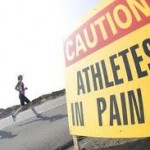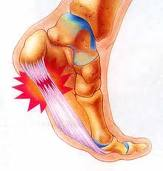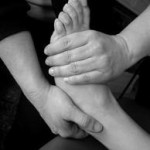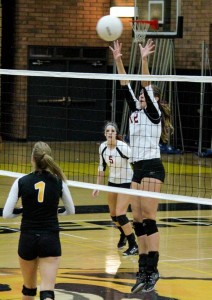Active Release Therapy in Gilbert, AZ
Neuromuscular Reeducation, Graston, Active Release Technique and ASTYM are all forms of deep tissue therapy which  breaks up adhesions, increases range of motion, reduces pain, and thereby may improve sports performance.
breaks up adhesions, increases range of motion, reduces pain, and thereby may improve sports performance.
Neuromuscular Reeducation preformed by Dr. Jeff Banas, is a form of Active Release Therapy which is a “stand-alone” hands-on technique/approach to the evaluation and functional treatment of 90+% of the soft tissue injuries a professional will see in practice. Every muscle in the body is surrounded by a smooth fascial sheath, every muscular fascicule and fibril are surrounded by fascia that can exert pressures of over 2,000 pound per square inch. When an area is injured, whether it’s muscle, connective tissue, fascia, tendon or some combination of these elements (as most injuries are), the body handles this inflammatory response of the tissues to trauma the only way it knows how, through a hyperplasia of the affected tissue followed by a fibrous healing, the laying down of a less elastic, second grade, poorly vascularized scar tissue to protect the involved areas. Adhesions occur wherever damage and inflammation have occurred and they limit both strength and range of motion. Active Release Therapy improves biomechanics by breaking up muscle adhesions.
Once there is fibrous healing these adhesions pull us out of a three dimensional orientation with gravity. As a muscle tendon begins to stretch and encounters an adhesion, the muscle contracts to prevent any further stretching and to protect the area involved.
 “Freeing the adhesion is only part of the battle,” according to Dr. Levy. “Each person has a subtle, complex and unconscious perception of his or her own body. When you have pain and limitation of motion due to an injury, you adapt your body image to fit that limitation. This unconscious mental adaptation can often persists long after the injury has been resolved without the “Reeducation” part of the technique.” “It isn’t enough to clear up a problem, we also have to convince the patients th
“Freeing the adhesion is only part of the battle,” according to Dr. Levy. “Each person has a subtle, complex and unconscious perception of his or her own body. When you have pain and limitation of motion due to an injury, you adapt your body image to fit that limitation. This unconscious mental adaptation can often persists long after the injury has been resolved without the “Reeducation” part of the technique.” “It isn’t enough to clear up a problem, we also have to convince the patients th t the problem is gone. Otherwise, they persist in favoring the area that was causing them pain. Patients may often limp for several months after a hip or leg problem has been eliminated, so the most important part of the treatment is in making the patients aware so that they can adapt their new behavior to the new physical reality.”
t the problem is gone. Otherwise, they persist in favoring the area that was causing them pain. Patients may often limp for several months after a hip or leg problem has been eliminated, so the most important part of the treatment is in making the patients aware so that they can adapt their new behavior to the new physical reality.”
The result is that the muscles involved are not as strong and the range of motion is limited in the involved joint. Adhesions can affect areas that are quite small, sometimes just a few muscle fibers, and other times there can be a number of areas like that scattered throughout a muscle group.
Article from Muscle and Fitness
I started lifting weights seriously when I was 15. I’ve continued as regularly as I could, given the constraints of a military career and lifestyle, for 24 of the last 30 years. I mean seriously enough that by the time I was in my early 20s I was pushing around some substantial weights. Then, like now, everyone wanted to be big. I was no exception. And in the belief that more weight meant more mass, more often than not, form was quietly sacrificed to quantity of iron moved in a give direction.
I had no instruction when I first got going, but was lucky enough not to suffer any serious problems. There were injuries of course, minor muscle pulls or ligament sprains, but nothing that ever slowed me down for an extended period. The hallmark of youth is resiliency and I bounced back from everything. At least I thought so.
In the last few years, though, I have to admit that I began to ache in a lot of different areas. At first, it was pretty localized, mainly in my shoulders and low back. But over time the ache became a dull, low-grade, pretty-much-constant state of my body. You know…you get out of bed a little slower and feel a bit stiff, creaky…you do a stretch and hear tissue crackle as you rotate your shoulders or hear your joints pop when you work your neck around. What’s worse is when you stretch and you can’t even get loose enough to pop a few bones and get some release. Some areas just don’t move, and the thought passes through your head that this might just be the beginning of “losing that flexibility” that you’ve always had.
The truth is that my neck didn’t move easily, both shoulders have hurt for 20 years on and off, the area between my shoulder blades felt locked up, my knees bothered me whenever I started using over 300 pounds for squats (even though I can easily do 20 reps with that weight and am always extremely careful about form and warm-up), and my low back had likewise been more and more of a problem over the past 10 years. And all this despite making sure over the years that I stretched correctly on a regular basis and that I balanced the work I did around and across each joint (i.e., balanced pushing movements with pulling, benches with rows, etc.).
This was not how I had intended to feel and I didn’t like it. About a month ago a friend of mine told me that there was a chiropractor in Santa Barbara doing some deep tissue work in addition to manipulation and that the results were impressive in the speed with which many problems, both acute and chronic, were cleared up. He had just opened a second office in Santa Monica. Now, I haven’t had much experience with chiropractors, and it was a 45-60 minute drive each way, but curiosity and hope prompted me to make an appointment.
“YOU’RE BORN LOOSE”
Dr. Peter Levy met me and brought me into a treatment room, where he took my medical history and performed an exam using primarily eccentric muscle tests, and static and dynamic palpation of the joints. I asked him what he considered the standard of health. “Flexibility,” he said at once. “Musculoskeletal, chemical and emotional flexibility. You’re born loose and you die stiff. Any loss of motion in between is a loss of vitality, a loss of function. Maybe just at a microtraumatic/microscopic level most of the time, but it adds up to a point where either you injure yourself pushing your newly restricted limits of joint and tissue tensile strength, or you find you just can’t do what you used to and you don’t know where it went.”
I understood him exactly. That’s precisely how I had been feeling for the last several years.
The exam included not just my neck, shoulders and low back but everything in between. Muscles are links in a chain of joints; they act together and are apt to suffer together; this is especially true of muscles on the sound side of the body which have a tendency to overwork.
“The key to understanding the technique I use, called Neuromuscular Re-education, is knowing about adhesions,” Levy said. All of a sudden the light bulb flashed on: This was the doctor that Dr. Gary Glum, cofounder of the Institute of Neuromuscular Re-education, had handpicked to carry on his work. Working with Joe Hourigan, Glum had developed this technique to market to insurance companies as a way of reducing treatment costs with less time off and longer lasting results. As it turned out, there didn’t seem to be much of a market for them in the world of big business, but soon world class athletes, including a great number of competitive body-builders and , were knocking on their door. Not long after that, Glum stopped practicing and turned his interests to writing a book on a cancer cure.
As Levy worked on my muscles and joints, he continued his explanation of the process.
“When an area is injured, whether it’s muscle, connective tissue, fascia, tendon or some combination of these elements (as most injuries are), the body handles this inflammatory response of the tissues to trauma the only way it knows how, through a hyperplasia of the affected tissue followed by a fibrous healing, the laying down of a less elastic, second grade, poorly vascularized scar tissue to protect the involved areas. Adhesions occur wherever damage and inflammation have occurred; they limit both strength and range of motion.
“Every muscle in the body is surrounded by a smooth fascial sheath, every muscular fascicule and fibril are surrounded by fascia that can exert pressures of over 2,000 pound per square inch. Neuromuscular Re-education is a hands-on approach to the evaluation, and structural and functional treatment of the human body and its injuries. Every time we experience a trauma, undergo an inflammatory process or even suffer from poor posture, the body adapts, restricting the fascial layers as well as the range of motion of the involved joints.
LAYERS OF AN ONION
“There may be an overall range of free movement, but at a joint or segmental level, irregular biomechanics are being set up by the restrictions. They act frequently like layers of an onion; as one set of adhesions is removed, underlying layers are revealed, as we slowly begin to lose our physiological adaptive capacity. We further lose our flexibility and spontaneity of motion, which sets us up for trauma, pain or restriction of motion.
“These adhesions pull us out of a three-dimensional orientation with gravity. As a muscle tendon begins to stretch and encounters an adhesion, the muscle contracts to prevent any further stretching and to protect the area involved. The result is that the muscles involved are not as strong and the range of motion is limited in the involved joint. Adhesions can affect areas that are quite small, sometimes just a few muscle fibers, and other times there can be a number of areas like that scattered throughout a muscle group.
“If you’re doing a squat, to use an extreme example, and even a small segment of the quadriceps stops contracting, you can put a lot of stress on the weakened area or on the other involved muscles that suddenly have to take up the slack. Also, if adhesions prevent a muscle from reaching proper extension, the increased stress on the tendons can contribute to tendonitis.”
As Levy was talking, he was working each of my shoulder joints through the entire range of motion, finding areas I had forgotten about specifically but realized -the moment his fingers found them – were critical to my proper function. He was applying deep and what most people would consider painful pressure in specific areas of all the muscles that cross the joint, not just the areas where the pain was. No one had ever worked on my pectoralis minor or subscapularis before, but he found them easily and paid special attention to the origin and insertion of those muscles. What an experience!
When he was done, I lifted my arms tentatively over my head and found that I had an amazing new range of motion.
Once the muscles were thoroughly freed up, he did a number of chiropractic manipulations including a bilateral scapular release that left me feeling that if I just moved my arms fast enough I could fly.
UNCONSCIOUS PERCEPTION
“Freeing the adhesion is only part of the battle,” Levy said. “Each person has a subtle, complex and unconscious perception of his or her own body. When you have pain and limitation of motion due to an injury, you adapt your body image to fit that limitation. This unconscious mental adaptation often persists long after the injury has been resolved.
“It isn’t enough to clear up a problem, we also have to convince the patients that the problem is gone. Otherwise they persist in favoring the area that was causing them pain. Patients may often limp for several months after a hip or leg problem has been eliminated, so an important part of the treatment is in making the patients aware so that they can adapt their new behavior to the new physical reality.” This, he said, is accomplished by:
Working each involved joint through the fullest possible range of motion during each session and then re-moving the fixations and subluxations with chiropractic manipulations, and sending a patient back to the activity that has been causing him or her the problem as soon as possible to demonstrate that the problem has been resolved.
Most bodybuilders and other athletes hope they can free adhesions on their own by forceful contractions and stretching, but this maneuver fails because:
The inhibitory feedback signals from the affected area prevent sufficient contracting or stretching to accomplish this, and the adhesions are not necessarily parallel to the muscle fibers and can lie any which way.
Dr. Peter Levy first met Dr. Gary Glum at Glurn’s last teaching seminar. Levy expressed doubt about some of Glum’s claims and Glum challenged him.
“Bring down any part of your body that has been bothering you,” Glum said. “If I can’t make it feel markedly better in several sessions, the cost of the seminar is on me.”
Levy paid for the seminar. Moreover, by the fifth session he was back playing competitive squash after a two-year layoff.
He spent the next year working with Glum in his Los Angeles office, commuting from Santa Barbara on weekends, to watch Glum and practice his technique on many of Glum’s patients. He became the team doctor to the Santa Barbara Men’s and Women’s Outrigger Clubs and went along in the support boat during the Molokai Channel race to work on the team members during their breaks. The Neuromuscular Re-education was so effective in acute problems that he started to use it on many of his patients with chronic problems.
“One of the best parts of this work is that active people get better faster,” Levy told me. “It’s rarely a long-term project with the exception of major tears and other injuries. If people need further attention we refer them to the top specialists in the area.”
Before I left at the end of my first visit, I reminded Levy about my low back and that both glutes had been weak when he strength-tested them, not to mention the years of discomfort. He said he’d get started on that next time. Before I left he adjusted my (jaw) joint and my occiput (base of the skull). I’ve been back to his office twice and have to admit I feel 1,000% better.
I’m back working with weights, my shoulders feel almost new again, my low back is much better and I’m wondering what else I can find to get fixed with this work. It’s a great combination, this Neuromuscular Re-education and Chiropractic applied as Levy does it. I don’t think he’s really reached into his bag of skills to deal with nutrition, allergies, detoxification or many of the other subjects we talked about. If things keep going as well as they have, look for more on Levy and his ideas in future issues.
MORE on Active Release